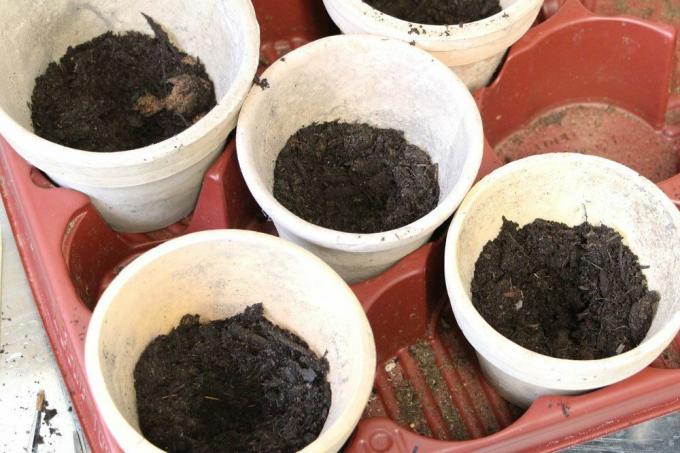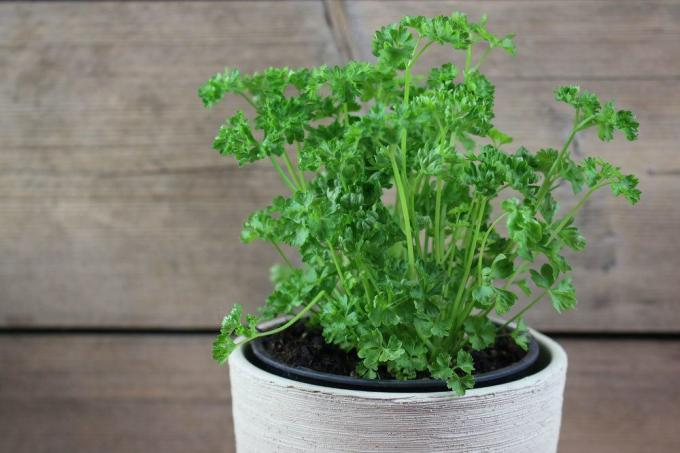
table of contents
- Planting parsley - instructions
- Choice of location
- Before sowing
- Optimal time
- Sow parsley outdoors
- Subsequent care
- Cultivation in a pot
- Plant in the garden
The versatile parsley (bot. Petroselinum crispum) has a reputation for being quite complicated when it comes to growing and growing. In fact, many hobby gardeners have problems with the popular culinary herb because it does not want to grow, the leaves turn yellow or the characteristic aroma does not really want to develop. Read what the Peterle - as the herb is also called in southern Germany and Austria - needs for strong and healthy growth. We explain how to plant parsley yourself, whether in bed or in a pot.
Planting parsley - instructions
Choice of location
The right location is particularly important for success, because the aromatic herb does not feel comfortable in every place in the garden. In order for the seeds to emerge and the plants to flourish, you should First carefully choose a suitable position before planting out.
Important criteria for a parsley bed are:
- not a full sun location
- as partially shaded as possible
- Nutrient-rich, humus soil that is as shaded as possible over midday
- loose and well-drained crumb structure
- slightly damp, but not prone to waterlogging
- as loamy as possible
- PH-level neutral

In addition, peterle must not be grown in the same place every year, as the umbelliferae are highly incompatible with themselves and with other umbelliferae.
Therefore, avoid mixed and subsequent crops with these types of plants:
- Leaf and root parsley
- Chervil, Lovage, Dill
- Anise and coriander
- Carrots and parsnips
- Celeriac and celeriac
- all kinds of fennel
On the other hand, the herb grows very well together with tomatoes, Onions, chives or radishes. The latter are even recommended as so-called marking seeds, i. H. They sow radish seeds together with parsley seeds. The course of the seed rows can be clearly seen from the radishes that emerge quickly.
Before sowing
Once the right location has been found, the soil should now be prepared for sowing. Parsley needs both deep and nutrient-rich subsoil, which is why it is best to plant it in the autumn before the planned sowing Either sow green manure first and submerge it after the first frost or in late autumn when digging up well-ripened compost subdivide. Then the garden bed does not have to be raked straight away, it is better to wait until after winter.
Frost crumbles the coarse chunks created by digging and thus ensures that the soil is particularly fine-crumbly. Only flatten the bed in March / April, weeding any that has emerged in the meantime weed and collect stones. Then pull out the seed rows and plant the seeds. But more on that in the next section.
Optimal time
Basically, you can sow parsley directly into the garden bed as early as March, if the weather permits. This is possible with
- permanent temperatures from seven degrees Celsius
- milder air
- no night frosts
- no ground frost
- mostly sunny, dry weather
- no continuous rain, no snow, no morning hoarfrost
However, since such conditions are seldom permanent so early in the year, early sowing is only recommended in regions with mild winter conditions. Elsewhere, you shouldn't put the parsley seeds into the ground until mid-April to May.
If you don't want to wait that long, you can use a cold frame for growing. The heat is concentrated under the glass, and seeds and young plants are protected from adverse weather conditions. Parsley seeds can also be used in the greenhouse. Maintain the little plants that grow from it either all year round in this protected area or put them outside from May.
Tip: If it is warm enough for sowing in April, the seeds can be planted in the garden bed. If night frost is imminent, protect seeds and young plants with a garden fleece or foil.
Sow parsley outdoors
After all the preparation and planning, you are now placing the parsley seeds in the bed. It is best to proceed as follows:
- Draw rows of seeds.
- Row spacing between 20 and 30 centimeters
- Groove depth one to two centimeters
- Seed quantity 200 to 300 seeds per running meter
- Mix the seeds with suitable radish seeds to mark them
- Then pour the mixture evenly into the furrows
- Cover carefully and loosely with soil
- Moisten the soil using a watering can with an attachment
- Cover with perforated film or fleece

Now you need patience, because it takes Peterle about three to four weeks to germinate. In addition, not all seeds come to life, as experience shows that the seeds - whether bought or collected themselves - have a high failure rate.
Tip: You can sow parsley not only in spring, but also in summer and even in autumn. For outdoor cultivation, the latest sowing date should be in June, after which it is best to grow the herb in the cold frame or in the greenhouse. Pot culture is also possible, in which case you can simply move the plant pots to a more sheltered location in bad weather.
Subsequent care
In the following weeks it is now important to keep the parsley bed evenly moist. The earth must not dry out, otherwise the seeds will not emerge. But be careful: Excessive moisture is also a disadvantage, because it makes the seeds moldy. So always take a watering can with an attachment and just moisten the surface. On the other hand, fertilization is not yet necessary; this only takes place when the young plants are larger and stronger.
Weather protection is also useful, especially in the rain and cold. For this purpose, keep fleece or foil ready with which you can cover the garden bed if necessary (follow the weather report!). As soon as the young plants have emerged and, in addition to the cotyledons that appear first, have developed the first correct pair of leaves, it is time to prick out. The gardener understands this term to mean simply plucking out young plants that are too close together so that the others have enough space to grow.
Prick out young plants
If necessary, you can use tweezers for pricking. Always remove the weaker-looking plants so that the stronger ones have better chances of growth. Basically, you don't need to pluck parsley too hard, as the plants in the bed can be quite tight. You should only keep the row spacing.

Tip: If you don't want to throw away the extracted plants, you can also plant them in pots and cultivate them on the windowsill. So you always have fresh parsley on hand and you don't have to run into the garden every time.
Cultivation in a pot
For a faster herb enjoyment, you can also prefer parsley from mid-January. After all, due to the long germination time and slow growth, it takes a long time before you can cut this herb for the first time after sowing. So it makes sense to shift the harvest time a little forward.
And this is how it works in pots:
- A shallow bowl is best.
- But pots and other planters also serve their purpose
- Fill in this potting soil.
- Herbal soil works too.
- Draw rows of seeds or press shallow hollows into the substrate.
- The seeds should be placed about an inch deep into the substrate.
- Parsley is a dark germ.
- However, a cold stimulus to interrupt the germ inhibition is not necessary.
- Cover the seeds with substrate.
- Moisten the substrate.
- Use a spray bottle for this.

Now place the cultivation vessel (s) in a bright, but not directly sunny, and warm location. The window sill of a window facing east or west is ideal, provided that no heating radiates heat directly under the vessels - this would allow the earth to dry out too quickly. Temperatures between 18 and 25 ° C are ideal for germination, as this is the fastest way. However, you still have to be patient for a few weeks.
Prick out the young plants as soon as they have formed the first correct pair of leaves. Put them in more nutrient-rich soil and take care of them now at slightly cooler temperatures. This is the first hardening so that the plants can be planted outdoors from April or May. Fertilization is not yet necessary.

Plant in the garden
Between mid-April and mid-May, the parsley plants that have grown early can finally be put into the bed. However, do not plant them out of the pot immediately when the weather is right, but slowly get used to the new location and the changed conditions. If this habituation phase is omitted, the young plants could eventually perish from the plant shock.
Getting potted plants used to the open field:
- from mid-April, weather permitting
- As warm as possible and rather dry, optimally overcast sky
- Place the pot in a sheltered, partially shaded place
- initially only for a few hours
- bring in overnight
Carry out this measure over a period of several days, gradually increasing the time the young plants are outside.
Finally, put them in the garden bed:
- Prepare the parsley bed as described for sowing.
- Dig it up as deep as a spade.
- Fold in well-ripened compost and horn meal.
- Break up larger clumps of earth.
- Rake the area smooth.
- Make furrows at intervals of 20 to 30 centimeters.
- Now plant the young plants along these furrows.
- The distance can be tight.
You should then water the freshly planted parsley vigorously to encourage it to grow in the garden soil.
Tip: Parsley bought in the supermarket is not suitable for planting in the garden or for a longer cultivation on the balcony or window sill. These specimens were grown very quickly in greenhouses under special conditions and do not tolerate natural circumstances - they therefore usually die very quickly. Therefore, it is more promising if you sow parsley yourself or buy young plants from a nursery.
